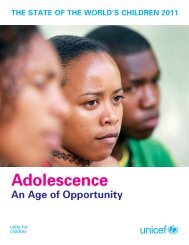The State of Food and Agriculture 2010-11: Women in ... - FAO
The State of Food and Agriculture 2010-11: Women in ... - FAO
The State of Food and Agriculture 2010-11: Women in ... - FAO
You also want an ePaper? Increase the reach of your titles
YUMPU automatically turns print PDFs into web optimized ePapers that Google loves.
W O M E N I N A G R I C U L T U R E : C L O S I n g t h e g e n d e r g a p f o r d e v E L O P m e n t<br />
9<br />
Answer: In most countries <strong>and</strong> <strong>in</strong> keep<strong>in</strong>g<br />
with global figures, women <strong>in</strong> rural areas<br />
who work for wages are more likely than<br />
men to hold seasonal, part-time <strong>and</strong> lowwage<br />
jobs <strong>and</strong> (controll<strong>in</strong>g for education,<br />
age <strong>and</strong> <strong>in</strong>dustry) women receive lower<br />
wages for the same work (see Chapter 2).<br />
Question 6: Are female-headed<br />
households the poorest <strong>of</strong> the poor<br />
Answer: Data from 35 nationally<br />
representative surveys for 20 countries<br />
analysed by <strong>FAO</strong> show that femaleheaded<br />
households are more likely to be<br />
poor than male-headed households <strong>in</strong><br />
some countries but the opposite is true<br />
<strong>in</strong> other countries – so it is not possible to<br />
generalize. Data limitations also make it<br />
impossible to dist<strong>in</strong>guish systematically<br />
between households headed by women<br />
who are s<strong>in</strong>gle, widowed or divorced (de<br />
jure female heads) <strong>and</strong> those who are<br />
associated with an adult male who supports<br />
the family through remittances <strong>and</strong> social<br />
networks (de facto female heads). It is<br />
likely that the former are more likely to<br />
be poor than the latter (Anríquez, <strong>2010</strong>).<br />
<strong>The</strong>re is also evidence to suggest that rural<br />
female-headed households were more<br />
vulnerable than males dur<strong>in</strong>g the food price<br />
shock <strong>of</strong> 2008 because they spend a larger<br />
proportion <strong>of</strong> household <strong>in</strong>come on food<br />
<strong>and</strong> because they were less able to respond<br />
by <strong>in</strong>creas<strong>in</strong>g food production (Zezza et al.,<br />
2008). Aga<strong>in</strong>, these results vary by country.<br />
Question 7: Are women <strong>and</strong> girls<br />
more likely than men <strong>and</strong> boys to be<br />
undernourished<br />
Answer: A positive answer to this<br />
statement is not supported by available<br />
evidence, <strong>and</strong> generalizations are difficult<br />
to make. <strong>The</strong> limited evidence available<br />
suggests that this may be true <strong>in</strong> Asia,<br />
while it is not true <strong>in</strong> Africa. More sexdisaggregated<br />
data <strong>of</strong> better quality on<br />
anthropometric <strong>and</strong> other <strong>in</strong>dicators <strong>of</strong><br />
malnutrition are needed to arrive at clear<br />
conclusions. <strong>The</strong>re is, however, evidence<br />
that girls are much more vulnerable to<br />
transitory <strong>in</strong>come shocks than boys (Baird,<br />
Friedman <strong>and</strong> Schady, 2007).<br />
Question 8: Are women more likely than<br />
men to spend additional <strong>in</strong>come on their<br />
children<br />
Answer: A very large body <strong>of</strong> research<br />
from many countries around the world<br />
confirms that putt<strong>in</strong>g more <strong>in</strong>come <strong>in</strong><br />
the h<strong>and</strong>s <strong>of</strong> women yields beneficial<br />
results for child nutrition, health <strong>and</strong><br />
education. Other measures – such as<br />
improv<strong>in</strong>g education – that <strong>in</strong>crease<br />
women’s <strong>in</strong>fluence with<strong>in</strong> the household<br />
are also associated with better outcomes<br />
for children. Exceptions exist, <strong>of</strong> course,<br />
but empower<strong>in</strong>g women is a well-proven<br />
strategy for improv<strong>in</strong>g children’s wellbe<strong>in</strong>g<br />
(see Chapter 4).<br />
<strong>in</strong> other countries where the female share<br />
<strong>of</strong> the agricultural labour force appears to<br />
have <strong>in</strong>creased dramatically, such as Pakistan<br />
where it has almost tripled s<strong>in</strong>ce 1980, to<br />
30 percent, <strong>and</strong> Bangladesh where women<br />
now exceed 50 percent <strong>of</strong> the agricultural<br />
labour force.<br />
<strong>The</strong> female share <strong>of</strong> the agricultural labour<br />
force <strong>in</strong> the Near East <strong>and</strong> North Africa<br />
appears to have risen substantially, from<br />
30 percent <strong>in</strong> 1980 to almost 45 percent.<br />
Some <strong>of</strong> the highest <strong>and</strong> fastest-grow<strong>in</strong>g<br />
rates <strong>of</strong> female agricultural labour force<br />
participation <strong>in</strong> the region are found <strong>in</strong><br />
Jordan, the Libyan Arab Jamahiriya <strong>and</strong> the<br />
Syrian Arab Republic.<br />
<strong>The</strong> countries <strong>of</strong> Lat<strong>in</strong> America have high<br />
overall female labour-force participation<br />
rates, but much lower participation <strong>in</strong><br />
agriculture than those <strong>in</strong> other develop<strong>in</strong>g<br />
country regions. This pattern reflects<br />
relatively high female education levels<br />
(see Chapter 4), economic growth <strong>and</strong><br />
diversification, <strong>and</strong> cultural norms that<br />
support female migration to service jobs<br />
<strong>in</strong> urban areas. Just over 20 percent <strong>of</strong> the
















